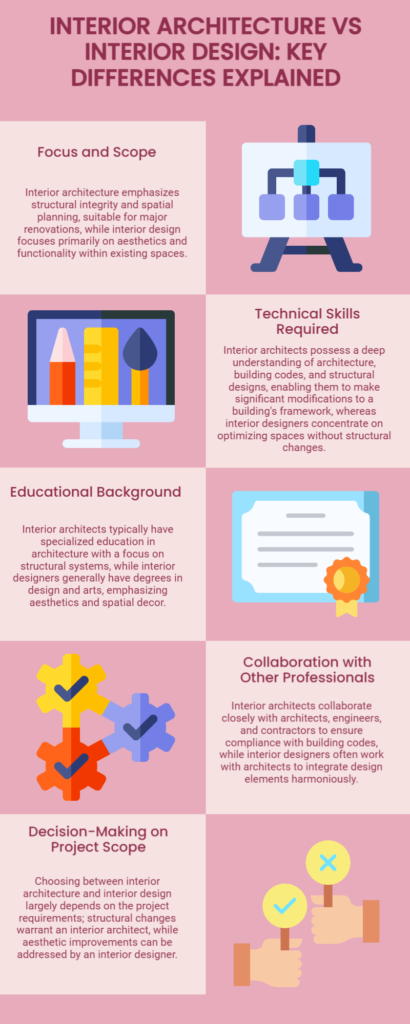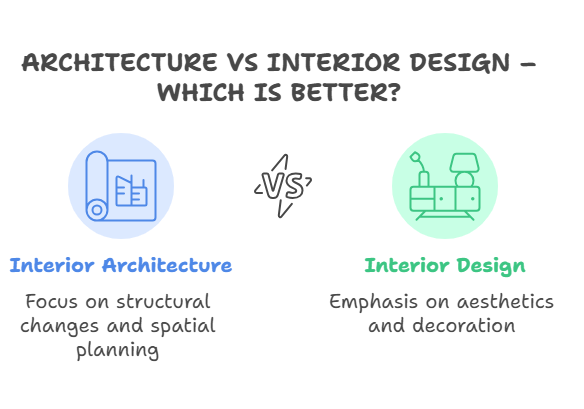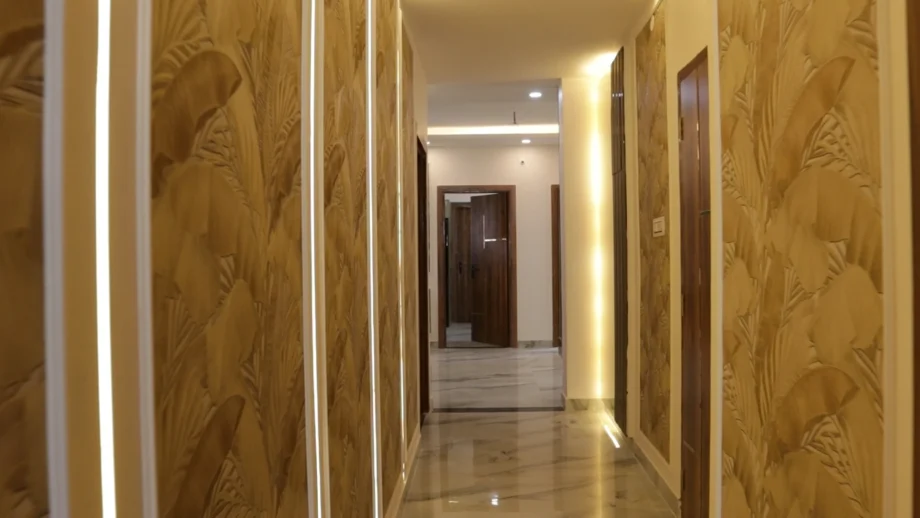Two terms spring to mind when the discussion veers towards creating aesthetically pleasing spaces.
They are – Interior Design and Interior Architecture.
In many cases, both of these terms are used interchangeably. However, they represent altogether tow distinctive professions. Professions that era different in terms of skill-sets, focuses, and above all, scopes.
Those looking to build or redesign or renovate their spaces need to understand before looking to select – Interior Architecture or Interior Design –which is better?

INTERIOR DESIGN AND INTERIOR ARCHITECTURE
INTERIOR DESIGN
Interior design indicates a process that is more focused on building’s interior. It is driven to usher in a more functional and aesthetically pleasing environment.
Interior designers
• Create layouts that are well-optimized and make maximum use of the available space.
• Focus more on decorations, furnishings, and overall aesthetics. At the same time, they also ensure the space is comfortable and functional.
• Work with a range of elements. Elements like fabrics, color schemes, furniture, lighting, textures, and flooring. The aim is to achieve a cohesive, visually appealing design.
• Involve often more in minor structural alterations. Like for instance, adding partitions or moving non-load bearing walls.
Also read :- best architect in Delhi ncr
RESPONSIBILITIES
• Focus on decoration and styling of interior spaces. The approach is to create a space layout that maximizes its functionality and flow.
• Choose materials and finishes. Like for instance, flooring options, wall colors, and wallpapers. They help to elevate the interior space.
• Choose, place, and style furniture and also decorative elements like curtains, art, lighting, and rugs.
• Select the right color palettes that help to get for the space the desired mood and theme.
INTERIOR ARCHIETCTURE
Interior architecture indicates a branch of architecture engaged in designing and shaping buildings’ interior spaces. The focus is more on spatial arrangements, structural elements, and functionality.
Interior architects
• Synergize design principles with elements of traditional architecture. They result in solutions that balance form as well as function.
• Involve more in the interior space’s technical aspects. This includes layout planning, material selection, and structural alterations. These can impact the building’s framework.
• Engage with a building’s architectural aspects. They require technical skills and knowhow that influence how the spaces are used like load-bearing walls, structural integrity, and building codes.
RESPONSIBILITIES
• Design, plan, and at times, alter the building’s internal structure. The approach is to make the building more appealing, safe, and functional.
• Select materials that are aesthetically pleasing and also durable. Additionally, they integrate into the design systems like electrical, plumbing, and HVAC.
• Work with the space’s structural elements. These elements are not just aesthetically pleasing but also are durable and efficient. Like for instance, beams, columns, and load-bearing walls.
• Involve often in effecting substantial alterations in the space’s internal structure. The approach is to ensure compliance with building codes and regulations.
• Design at times built-in furniture, optimize layouts for better flow, and above all, work on elements like ventilation, acoustics, and lighting.
INTERIOR ARCHITECTURE VS INTERIOR DESIGN – KEY DIFFERENCES
Both are different. The differences lie in the scope and nature of their work, expertise, and educational background.
FOCUS AND SCOPE:
• INTERIOR ARCHITECTURE: It involves physical structure of a space and often works with major renovations. The whole process deals with the interior’s overall architecture. Focus is more on spatial planning and structural integrity; and how the interior works as a whole in relation to the building spaces.
• INTERIOR DESIGN: Focus is more on the space’s aesthetics and decoration. It requires careful and proper arrangement of colors, textures, furniture and lighting. The whole approach is to create a visually pleasing setting that caters to a purpose.
TECHNICAL SKILLS
• INTERIOR ARCHITECTS: Need to have technical knowledge of architecture as well as building codes and structural design. If they have, they are entitled to make alterations to the building’s internal framework like adjustment of layouts or moving of walls.
• INTERIOR DESIGNERS: Focus more on how existing spaces can be optimized and made to look attractive. They have more skills in design principles, as well as spatial arrangement, color theory, and furniture selection.
EDUCATIONAL BACKGROUND
• INTERIOR ARCHITECTS: Specialize in the interior aspects of the building. Their level of education in many ways involves deep understanding of design principles alongside building construction, architectural systems, and materials.
• INTERIOR DESIGNERS: Have background in design supplemented by degrees in areas like the arts, architecture, or interior design. There could be in some cases specialized in architecture but their focus will be more on interior’s artistic and functional aspects
STRUCTURAL CHANGES
• INTERIOR ARCHITECTS: Tend to have sound knowledge and expertise in interior structures. This allows them to effect alterations in or even redesign the building’s interior structure. Like for instance, adding structural elements including beams, arches, or columns; or shifting walls.
• INTERIOR DESIGNERS: Tend to work within the building’s prevalent structure. They should have specific training or certifications in interior architecture or construction. Else, they may not be allowed to effect structural alterations.
COLLABORATION WITH OTHER PROFESSIONALS
• INTERIOR ARCHITECTS: Coordinate with architects closely. They also work with contractors and engineers. They all together ensure the interior design plans align with structural and building codes.
• INTERIOR DESIGNERS: Collaborate with architects and interior architects. They together ensure design elements blend with the overall architecture of the building.
DIFFERENCES BETWEEN INTERIOR DESIGNER AND ARCHITECT
An interior architect oversees and manages the building’s complete design. On the other hand, an interior designer focuses more on interior spaces. They ensure the interior spaces are aesthetically beautiful and functional.
ARCHITECTURE VS INTERIOR DESIGN – WHICH IS BETTER?
It’s a tricky battle when it comes to deciding – Interior Architecture OR Interior Design – Which Is Better?
It all depends finally on what you are seeking to realize with your space.
If you’re looking for a beautiful building design and overall structure, OR looking to effect major changes to the building’s internal framework, then Interior Architecture should be your choice. Interior architects are better fit for projects that need a detailed knowledge of structural engineering and technicalities of designing functional spaces with building codes.

On the other hand, if your intention is a stylish and well-organized interior setting sans alteration of the building’s structure, then Interior Design is a better option. That’s because interior designers can enhance a space’s aesthetic appeal, optimize space layouts, and select materials aligned with your taste and functional needs.
Finally, both bring to the table their own brand of skills. The skills may be distinct serving different purposes but they are on one page when it comes catering to customer’s requirements.
CONCLUSION
In interior design, the focus is more on the space’s aesthetic, decorative, and functional aspects. On the other hand, in interior architecture, the focus is on integrating architectural needs with structural changes into interior layouts.
By carefully understanding the nature of their work and key differences, you will be in a better position to make more informed decisions.
Read more about selecting the best architect in Gurgaon for modern designs.
Leading architectural design firm, P and M Creations specializes in creating delightful spaces. Spaces that is visually pleasing as well as practical and comfortable. The firm has a solid team of skilled interior architects and interior designers. They possess sound understanding of building systems as well as aesthetics and functionality.
FAQ’S
What does an Interior Architect do?
An interior architect offers architecture knowledge and design expertise. They
focus more on creating interior layouts and designs that are visually appealing and
structurally sound. They collaborate closely with architects and designers. Together
they work to ensure the structure as well as aesthetics remain in harmony.
Can an interior designer be an interior architect?
Yes. That is if they have additional qualifications and training in architecture.
However to be an interior architect, they need to have advanced education in
architecture with an understanding of structural elements, building regulations, and
construction.
Which is better for residential spaces among the two – Interior Design and Interior Architecture?
Both are suitable for residential spaces. However the choice depends on your
project’s scope. If you are looking to renovate a home or just want to make
significant structural alterations, then Interior Architecture will be more suitable.
That’s because they help to redesign the whole layout and ensure they fit the
desired functionality.
Interior design is suitable for designing the room’s look and feel without altering
structural features or walls. They are also suitable if you’re looking to make more
cosmetic alterations. The designer will focus on furniture and color schemes aside
from the overall ambiance.
Is it possible for interior architects and designers to work together?
Yes. They in many ways collaborate on projects to ensure the best possible
results. Interior architects work on the functional and structural aspects. Interior
designers on the other hand, focus on aesthetics and décor. Together they work to
make sure the space looks beautiful as well as functional.
Is it possible for an interior designer to effect architectural alterations?
An interior designer can make minor adjustments to the space. Like for instance,
choosing new materials or moving furniture. However for major changes, interior
architect is required. Like for instance, modify walls, structural elements, or
ceilings.


